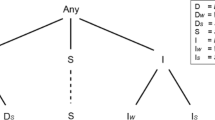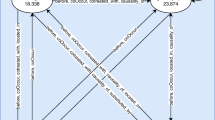Abstract
Coping with time series cases is becoming an important issue in applications of case based reasoning in medical cares. This paper develops a knowledge discovery approach to discovering significant sequences for depicting symbolic time series cases. The input is a case library containing time series cases consisting of consecutive discrete patterns. The proposed approach is able to find from the given case library all qualified sequences that are non-redundant and indicative. A sequence as such is termed as a key sequence. It is shown that the key sequences discovered are highly valuable in case characterization to capture important properties while ignoring random trivialities. The main idea is to transform an original (lengthy) time series into a more concise representation in terms of the detected occurrences of key sequences. Four alternative ways to develop case indexes based on key sequences are suggested and discussed in detail. These indexes are simply vectors of numbers that are easily usable when matching two time series cases for case retrieval. Preliminary experiment results have revealed that such case indexes utilizing key sequence information result in substantial performance improvement for the underlying case-based reasoning system.
Similar content being viewed by others
References
Aamodt A, Plaza E (1994) Case-based reasoning: foundational issues, methodological variations and systems approaches. AI Commun 7:39–59
Agrawal R, Srikant R (1995) Mining sequential patterns. In: Proceedings of the 11th international conference on data engineering, pp 3–14
Baccigalupo C, Plaza E (2006) Case-based sequential ordering of songs for playlist recommendation. In: Roth-Berghofer TR et al. (eds) Proceedings of the European conference on case-based reasoning. Springer, Berlin, pp 286–300
Bellazzi R, Larizza C, Riva A (1998) Temporal abstractions for interpreting diabetic patients monitoring data. Intell Data Anal 2:97–122
Bichindaritz I, Conlon E (1996) Temporal knowledge representation and organization for case-based reasoning. In: Proceedings TIME-96. IEEE Computer Society, Washington, pp 152–159
Chan KP, Fu AW (1999) Efficient time series matching by wavelets. In: Proceedings of the international conference on data engineering, pp 126–133
Garofalakis MN, Rajeev R, Shim K (1999) SPIRIT: sequential pattern mining with regular expressing constraints. In: Proceedings of the 25th international conference on very large data bases, pp 223–234
Jaere MD, Aamodt A, Skalle P (2002) Representing temporal knowledge for case-based prediction. In: Craw S, Preece A (eds) Proceedings of the European conference on case-based reasoning, pp 174–188
Jarmulak J, Craw S, Rowe R (2000) Genetic algorithms to optimise CBR retrieval. In: Blanzieri E, Portinale L (eds) Proceedings of the European conference on case-based reasoning. Springer, Berlin, pp 136–147
Martin FJ, Plaza E (2004) Ceaseless case-based reasoning. In: Funk P, Gonzales Calero PA (eds) Proceedings of the European conference on case-based reasoning. Springer, Berlin, pp 287–301
McSherry D (2004) Explaining the Pros and Cons of conclusions in CBR. In: Proceedings of the European conference on case-based reasoning, pp 317–330
Montani S et al. (2006) Case-based retrieval to support the treatment of end stage renal failure patients. Artif Intell Med 37:31–42
Montani S, Portinale L (2005) Case based representation and retrieval with time dependent features. In: Proceedings of the international conference on case-based reasoning. Springer, Berlin, pp 353–367
Nilsson M, Funk P (2004) A Case-based classification of respiratory sinus arrhythmia. In: Proceedings of the 7th European conference on case-based reasoning, Madrid. Springer, Berlin, pp 673–685
Olsson E, Funk P, Xiong N (2004) Fault diagnosis in industry using sensor readings and case-based reasoning. J Intell Fuzzy Syst 15:41–46
Perner P (2003) Incremental learning of retrieval knowledge in a case-based reasoning system. In: Ashley KD, Bridge DG (eds) Proceedings of the international conference on case-based reasoning. Springer, Berlin, pp 422–436
Salton G (1968) Automatic information organization and retrieval. McGraw–Hill, New York
Schmidt R, Heindl B, Pollwein B, Gierl L (1996) Abstraction of data and time for multiparametric time course prognoses. In: Advances of case-based reasoning. Lecture notes in artificial intelligence, vol 1168. Springer, Berlin, pp 377–391
von Schéele B (1999) Classification Systems for RSA, ETCO2 and other physiological parameters. PBM Stressmedicine. Technical Report, Heden 110, 82131 Bollnäs, Sweden
Shahar Y (1997) A framework for knowledge-based temporal abstractions. Artif Intell 90:79–133
Srikant R, Agrawal R (1996) Mining sequential patterns: generalizations and performance improvements. In: Proceedings of the 5th international conference on extending database technology, pp 3–17
Wu Y, Agrawal D, El Abbadi A (2000) A comparison of DFT and DWT based similarity search in time series databases. In: Proceedings of the 9th ACM CIKM conference on information and knowledge management, McLean, VA, pp 488–495
Zelikovitz S, Hirsh H (2002) Integrating background knowledge into nearest-neighbor text classification. In: Craw S, Preece A (eds) Proceedings of the European conference on case-based reasoning. Springer, Berlin, pp 1–5
Author information
Authors and Affiliations
Corresponding author
Rights and permissions
About this article
Cite this article
Xiong, N., Funk, P. Concise case indexing of time series in health care by means of key sequence discovery. Appl Intell 28, 247–260 (2008). https://doi.org/10.1007/s10489-007-0059-x
Received:
Accepted:
Published:
Issue Date:
DOI: https://doi.org/10.1007/s10489-007-0059-x




